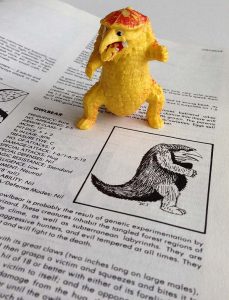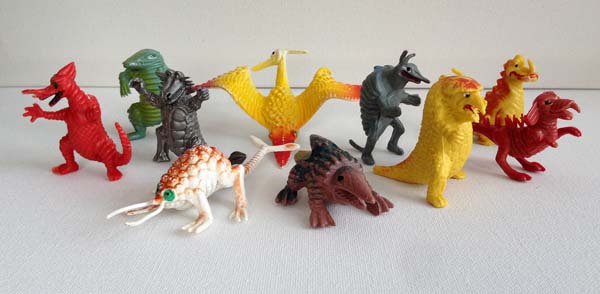
In the early 1970s, Gary Gygax was undoubtedly wearing some bell bottom polyester trousers with an open wide-collar disco shirt, as he watched some ChiPS on his 4 channel black and white TV. He was also playing with toys, looking for what might be new monsters to populate the dungeons of the new game he had just created–Dungeons and Dragons.
He came across a bag of plastic toys from Hong Kong that were labeled “prehistoric animals.” It was a set modeled after monsters from Japanese “Kaiju” films such as Ultraman, Mothra, and the Godzilla franchise. One of these plastic toys was odd enough to catch his eye and make him look away from Ponch and John.
It was a tiny plastic toy that looked like a bear and an owl had a baby.
The result was the Owlbear, now an iconic D&D monster that has appeared in every single edition of the game.
An owlbear is described as a ten foot tall cross between a bear and an owl. Owlbears are carnivorous creatures who live as mated pairs in caves. Famed for their aggression and ferocity, Owlbears hunt any creature bigger than a mouse. They use their beak and a “hug” to attack.
They are categorized as “magical beasts”, which makes sense, as their origin indicates that they are probably the product of a wizard’s experiments. ‘A wizard did it’ makes sense, as the trope of a “madman tinkering with bizarre mutations” is a big part of our Sci-Fi/Fantasy fiction mythology.
But who cares about the Owlbear origin story, we want to know what sound they make! Well, the answer to that is not so simple. Let’s go through the Owlbear edition by edition.
[bs_smart_list_pack_start][/bs_smart_list_pack_start]
1st Edition

Does an owlbear hoot? Does it roar? Unfortunately, Gary Gygax didn’t speak of the sound of an owl bear in D&D 1e, nor did he give an extensive ecology. Here’s the original description:
A horrid creature which “hugs” like a bear, and deals damage with its beak.
D&D 2e
The second edition of the game is where we get somewhere, mainly because both Dungeon and Dragon magazines were excellent resources for D&D lore expansion. Here’s a blurb from a short story in Dragon #214, taken from an article titled the Ecology of the Owlbear:
The creature shuffled out of the cave, reared up on its hind legs, and stretched. […] The creature stood a full 8’ tall, the brown feathers of its owlish head merging seamlessly into the fur of its body, somewhere past its shoulders and back. […] Griff took aim, drew a short breath, and let out with a quiet “hoot.”
Immediately, the owlbear reared up, and Griff tightened his finger on the trigger. There was the quick twang of the crossbow, and the bolt went lightning-quick into the owlbear’s right eye.
The screech was incredible. Colin covered his ears with both hands, amazed at the sheer intensity of the creature’s deaththroes.
The article goes on to explain that owlbears can communicate via an entire language of screeches.
D&D 3e Pathfinder
The 3rd edition of D&D didn’t add much to the owlbear but Paizo stepped up big time in their Pathfinder RPG. Paizo’s Dungeon Denizens Revisited , Behind the Monsters, and other supplements includes several variants of the owlbear, such as the siege owlbear, arctic owlbear, Darklands owlbear, fruss owlbear, great hook-clawed owlbear, screaming owlbear, sleeyk owlbear, slime owlbear, sloth owlbear as well as the spectral owlbear. Whew.
Furthermore, Paizo introduces us to the bearowl, the possibly “even stranger offspring” of an owlbear. But not much on the sounds they make. Seriously, do they hoot?
4e D&D
The 4e owlbear had an encounter power called ‘Stunning Screech’, which was an an ability that suggested a sound.
5e D&D
This brings us to today and the 5th edition of Dungeons and Dragons. This is from the Monster Manual:
An owlbear’s screech echoes through dark valleys and benighted forests, piercing the quiet night to announce the death of its prey.
There you have it, back to the ‘screech’ which at this point has probably been codified as the sound an owlbear makes.
But that doesn’t answer another question I have? Do owlbears lay eggs?

